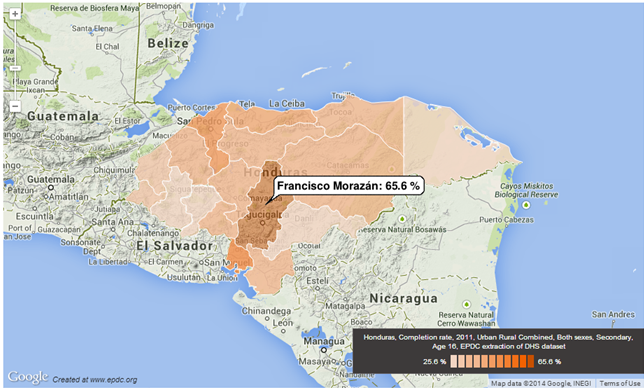You are here
EPDC Spotlight on Honduras
By: Kemi Oyewole and Khaled Al-Abbadi
Continuing our focus on education in Central America, this EPDC Spotlight on Honduras points out the limited educational opportunities many Honduran youth have for secondary education.
Honduras is a Central American country with a population of 8.6 million people. The nation is bordered by Guatemala to the west, Nicaragua to the southeast, and El Salvador to the southwest. During the summer of 2014, substantial attention has focused on Honduran children due to the influx of unaccompanied minors crossing the southern border of the United States. Many Honduran children are believed to be making this dangerous journey to flee world’s highest murder rate and street gangs that terrorize communities. The impact this lack of security has on children’s futures is also manifest in educational outcomes in Honduras.
Age six is the official age of primary school entry in Honduras. Basic education includes six years of primary school and three years of lower secondary school. In principle, basic education in Honduras is free and compulsory. Following basic education, the academic track of upper secondary consists of two additional years of schooling.
.png)
Education Data: A Snapshot
The EPDC National Education Profile for Honduras shows Honduras is in the 81st percentile among Latin American countries for its female primary school completion rate and in 59th percentile for its male primary school completion rate. Beyond primary school, only 50.5 percent of female Hondurans and 37.5 percent of male Hondurans completed secondary school in 2011. Across departments, the highest secondary school completion rate is 65.6 percent in Francisco Morazán and the lowest rate is 25.6 percent in Intibucá (Figure 1). These figures illustrate the limited opportunity that youths in Honduras have to complete their secondary education, especially males.
Figure 1: Secondary School Completion Rates in Honduras
The disproportionate effect economic and social disruption in Honduras have had on males is further evidenced in the rates of children out of school. Approximately 41% of male adolescents of secondary school age (i.e. ages 12-16) are out of school, compared to 34% of females of the same age. Both of these rates are high; Honduras is in the 10th percentile regionally in the percent of children out of school. Though disparities exist between the rates of out of school children in urban and rural areas, the biggest disparities can be seen between the richest and the poorest quintile. Nearly 62% of adolescents from the poorest quintile are out of school, indicating out of school adolescents tend to be poor males.
Another indicator of the disproportionate effect on males is the youth employment rate. In 2011, nearly 41% of male youth ages 15-17 in Honduras reported being economically active and not enrolled in schooling compared to only 9% of females (SITEAL). This trend explains the rates at which males access tertiary education. Between 2010 and 2012, the number of male pupils in post-secondary education fell by 6.8 percent while the number of female pupils rose by 11.3 percent. Such discouraging trends offer an explanation for the reason many of the unaccompanied minors seeking refuge in the United States are males between the ages of 15 and 17.
Learning Outcomes
Honduras is one of the lowest performers in learning outcomes measures when compared to other countries in Latin America and the Caribbean. The youth literacy rate, for ages 15-24, in Honduras is at the 20th percentile regionally and approximately 40th percentile globally. Honduras’ participation in the PIRLS international reading assessment in 2006 is also telling. Only 1% of the sixth grade test takers performed at the highest performance benchmark, compared to an average of 8% for all PIRLS participating countries. Moreover, 26% of test takers performed below the lowest performance benchmark, compared to an average of 13% for all participating countries. Although unfortunately Honduras did not participate in the first two rounds of the regional reading and math assessments for Latin America and the Caribbean (PERCE and SERCE), it is party to the third round (TERCE) along with 14 other Latin American countries. Results are schedule to be released in December 2014; learn more about learning assessments and access data at the EPDC website.
In Honduras, each year students are assessed through Proyecto Mejorando el Impacto al Desempeño Estudiantil de Honduras (MIDEH), a USAID funded project which assess Spanish and mathematics for students in the first through ninth grades of school. The EPDC National Learning Assessments Mapping Project (N-LAMP) found that the MIDEH assessments mapped to two of the seven dimensions deemed essential for learning by the Brookings Institution and UNESCO Institute for Statistics Learning Metrics Task Force. This aligns well with N-LAMP findings that national large-scale student assessments (NLSAs) test fewer dimensions of learning than high stakes exams, on average 2.7 dimensions per NLSA and 4.3 dimensions per high stakes exam.
Youth Workforce Readiness
Proyecto Metas, the Honduran award of the Educational Quality Improvement Program 3 (EQUIP3), has provided pathways for young Hondurans to complete skills training or to finish traditional education through alternative education programs. This iteration of the project has led to over 35,500 youth enrolled in institutions training in basic job skills and numerous intersectoral partnerships connecting program training to employer needs. Continued success with training programs increases the employability of participants. With youth unemployment rates almost twice the national average programs like this have the potential to stem the flow of young people participating in illicit activities.
EPDC Resources
Among other sources, unique EPDC data collections for Honduras include data from the USAID Demographic and Health Surveys (2004, 2005, 2006, 2012), Sistema de Información de Tendencias Educativas Educativas en América Latina (1990, 2001, 2004, 2006, 2007, 2009), and other indicators derived from the UNESCO Institute for Statistics. The EPDC website offers users the opportunity to create graphs, charts, and other visualizations of data with an easy-to-use tool.


Add new comment